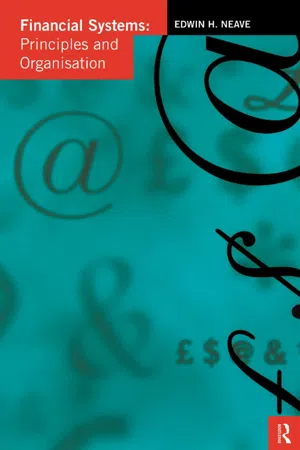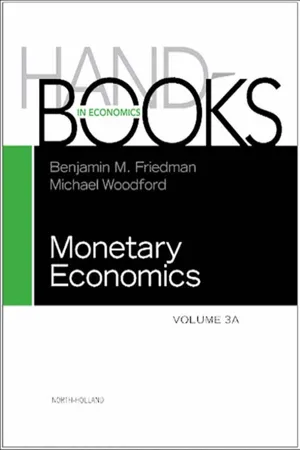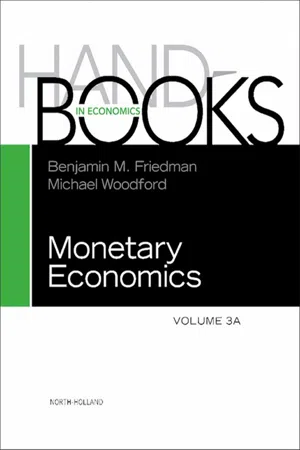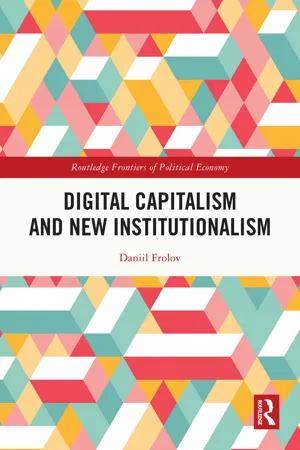Economics
How Financial Intermediaries Reduce Transaction Costs
Financial intermediaries reduce transaction costs by pooling funds from multiple investors, which allows for economies of scale in investment and lending activities. They also provide expertise in evaluating and monitoring investment opportunities, reducing the information asymmetry between borrowers and lenders. By performing these functions, financial intermediaries help to facilitate efficient allocation of capital in the economy.
Written by Perlego with AI-assistance
Related key terms
4 Key excerpts on "How Financial Intermediaries Reduce Transaction Costs"
- eBook - ePub
Financial Systems
Principles and Organization
- Edwin H. Neave(Author)
- 2002(Publication Date)
- Routledge(Publisher)
This chapter examines strategic management in financial intermediaries. One of the most important of an intermediary’s strategic decisions is choosing its organisational structure. A second, equally important challenge is preparing the firm to respond to future changes—either in its markets or in the technology it might employ. The chapter first outlines the factors affecting profitability when intermediaries consider whether their organisational structure might better be that of a multiproduct or a specialised firm. Next, the chapter examines economic issues that arise in adapting to changing markets or to technological change. Third, the chapter outlines the basic economics of intermediary operations. Finally, the chapter develops a model explaining how balancing expected profitability against risk can be studied.15.2 ECONOMICS OF INTERMEDIATION
Like any financial firm, intermediaries structure themselves to meet and if possible outperform the competition. Management tries to lead or at least keep abreast of market developments, and at the same time tries to operate as profitably as possible. Meeting these two challenges means that intermediaries adapt their business to changing opportunities. As one example, intermediaries still perform their traditional role of raising funds through deposits and repackaging the funds as loans, but they are increasingly also acting as agents for financings they do not retain on their own books.In performing their traditional roles, intermediaries gather savings deposited in small individual accounts and then lend out the funds in typically larger amounts— an activity sometimes called denomination intermediation. They employ maturity intermediation when they use their short term funds (i.e., funds deposited in chequing and savings accounts) to finance medium term loans. Intermediary operations also transform risk: the depositing client of an intermediary does not face the same default risk as she would if she lent funds directly to one of the intermediary’s clients. The depositor’s risk is related to the diversified risk of the intermediary’s asset portfolio rather than to the credit risk of the borrowing client. Risk is also transformed when portfolios of intermediary loans are securitised: the original loans are repackaged into a diversified portfolio which is then offered as collateral for securities purchased by institutional investors.Despite the advantages of diversification, the uninsured depositor can still face default risk: unsound lending practices can cause an intermediary to fail. Thus when deciding where to place their short term funds, large depositors are wise to take the intermediary default risk into account. On the other hand, small depositors do not face default risk in jurisdictions where their funds are protected by deposit insurance.1 - eBook - ePub
- Benjamin M. Friedman, Michael Woodford(Authors)
- 2010(Publication Date)
- North Holland(Publisher)
In conventional models of monetary economics commonly used in central banks, the banking sector has not played a prominent role. The primary friction in such models is the price stickiness of goods and services. Financial intermediaries do not play a role, except as a passive player that the central bank uses as a channel to implement monetary policy.However, financial intermediaries have been at the center of the global financial crisis that erupted in 2007. They have borne a large share of the credit losses from securitized subprime mortgages, even though securitization was intended to parcel out and disperse credit risk to investors who were better able to absorb losses. Credit losses and the associated financial distress have figured prominently in the commentary on the downturn in real economic activity that followed. These recent events suggest that financial intermediaries may be worthy of separate study to ascertain their role in economic fluctuations.The purpose of this chapter is to reconsider the role of financial intermediaries in monetary economics. In addressing the issue of financial factors in macroeconomics, we join a spate of recent research that has attempted to incorporate a financial sector in a New Keynesian DSGE model. Curdia and Woodford (2009) and Gertler and Karadi (2009) are recent examples. However, rather than phrasing the question of how financial “frictions” affect the real economy, we focus on the financial intermediary sector. We explore the hypothesis that the financial intermediary sector, far from being passive, is instead the engine that drives the boom-bust cycle. To explore this hypothesis, we propose a framework for study to address the following pair of questions. What are the channels through which financial intermediaries exert an influence on the real economy (if at all)? What are the implications for monetary policy?Banks and other financial intermediaries borrow in order to lend. Since the loans offered by banks tend to be of longer maturity than the liabilities that fund those loans, the term spread is indicative of the marginal profitability of an extra dollar of loans on intermediaries' balance sheets. The net interest margin (NIM) of the bank is the difference between the total interest income on the asset side of its balance sheet and the interest expense on the liabilities side of its balance sheet. Whereas the term spread indicates the profitability of the marginal loan that is added to the balance sheet, the NIM is an average concept that applies to the stock of all loans and liabilities on the balance sheet. - eBook - ePub
- (Author)
- 2010(Publication Date)
- North Holland(Publisher)
In conventional models of monetary economics commonly used in central banks, the banking sector has not played a prominent role. The primary friction in such models is the price stickiness of goods and services. Financial intermediaries do not play a role, except as a passive player that the central bank uses as a channel to implement monetary policy.However, financial intermediaries have been at the center of the global financial crisis that erupted in 2007. They have borne a large share of the credit losses from securitized sub-prime mortgages, even though securitization was intended to parcel out and disperse credit risk to investors who were better able to absorb losses. Credit losses and the associated financial distress have figured prominently in the commentary on the downturn in real economic activity that followed. These recent events suggest that financial intermediaries may be worthy of separate study to ascertain their role in economic fluctuations.The purpose of this chapter is to reconsider the role of financial intermediaries in monetary economics. In addressing the issue of financial factors in macroeconomics, we join a spate of recent research that has attempted to incorporate a financial sector in a New Keynesian DSGE model. Curdia and Woodford (2009) and Gertler and Karadi (2009) are recent examples. However, rather than phrasing the question of how financial “frictions” affect the real economy, we focus on the financial intermediary sector. We explore the hypothesis that the financial intermediary sector, far from being passive, is instead the engine that drives the boom-bust cycle. To explore this hypothesis, we propose a framework for study to address the following pair of questions. What are the channels through which financial intermediaries exert an influence on the real economy (if at all)? What are the implications for monetary policy?Banks and other financial intermediaries borrow in order to lend. Since the loans offered by banks tend to be of longer maturity than the liabilities that fund those loans, the term spread is indicative of the marginal profitability of an extra dollar of loans on intermediaries’ balance sheets. The net interest margin (NIM) of the bank is the difference between the total interest income on the asset side of its balance sheet and the interest expense on the liabilities side of its balance sheet. Whereas the term spread indicates the profitability of the marginal loan that is added to the balance sheet, the NIM is an average concept that applies to the stock of all loans and liabilities on the balance sheet. - eBook - ePub
- Daniil Frolov(Author)
- 2023(Publication Date)
- Routledge(Publisher)
But the minimization of transaction costs can be considered as a special case of increasing transaction value, while the transaction benefits of institutions are not limited to cost reduction. However, it is the latter point of view that is the most common. At the same time, it is ignored that the reduction of transaction costs associated with any institution, after a certain threshold value, inevitably begins to negatively affect the quality of transactions coordinated by it. Transaction cost theory’s emphasis on institutions for low-cost transactions is stimulated by the continued existence of high-cost institutional structures that are lobbied by intermediaries in many areas. In industrial societies, too many professional communities have become gatekeepers, guarding the sources of their knowledge and the secrets of practical expertise (Susskind and Susskind 2022). Professionals deliberately increased transaction costs (prices of their transaction services); they were de facto imposed intermediaries in their professional areas, selling clients a reduction of initially inflated transaction costs (see more in Munger 2018). Intermediation-based costly institutions promote extractive (rent-seeking) economic development, so from the point of view of the frictional paradigm, they should be replaced by more efficient, lower-cost institutions. But low-cost institutions are far from a universal recipe for increasing the effectiveness of transactions. The more complex the transactions (for example, the more knowledge-intensive they are), the more important is not the low transaction costs, but the high transaction value provided by institutions. After all, more complex transactions, as a rule, involve greater costs, proportional to the degree of their complexity. These costs are essentially transaction investments, not just costs
Index pages curate the most relevant extracts from our library of academic textbooks. They’ve been created using an in-house natural language model (NLM), each adding context and meaning to key research topics.



